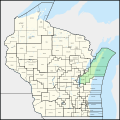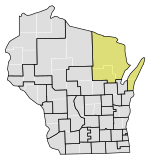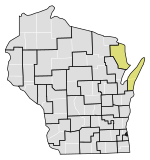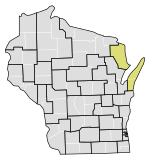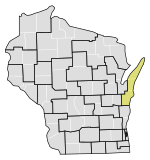| Wisconsin's 1st State Senate district | |||||
|---|---|---|---|---|---|
2024 map defined in 2023 Wisc. Act 94 2022 map defined in Johnson v. Wisconsin Elections Commission 2011 map was defined in 2011 Wisc. Act 43 composed of Assembly districts 1, 2, and 3 | |||||
| Senator |
| ||||
| Demographics | 92.66% White 0.81% Black 3.1% Hispanic 1.35% Asian 1.51% Native American 0.07% Hawaiian/Pacific Islander | ||||
| Population (2020) • Voting age | 178,600 138,622 | ||||
| Website | District website | ||||
| Notes | Door Peninsula and northeast Wisconsin | ||||
The 1st Senate district of Wisconsin is one of 33 districts in the Wisconsin Senate. [1] Located in northeast Wisconsin, the district comprises all of Door and Kewaunee counties, as well as nearly all of Calumet County, much of northern and western Manitowoc County and eastern and southern Brown County, along with parts of southwest Outagamie County. It includes the cities of Sturgeon Bay and Chilton and parts of the cities of Appleton, Menasha and Green Bay. [2]
